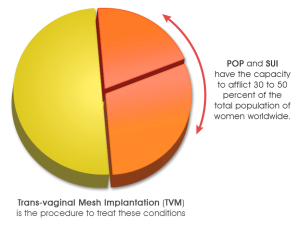 Incontinence forms part of women’s greatest fears as they get close to delivering their first babies and as they reach the age when every part of their bodies start to sag down, health journals say. With the eyes of the world on these health issues, medical product designers and distributors are slowly making up-to-date devices. However, because of the fast-tracking of inadequately evaluated implants, many patients have acquired complications they were not even warned of. An impressively growing number of groups, including medical staffs, have recently been calling out for a more responsible device testing which the FDA is still looking into.
Incontinence forms part of women’s greatest fears as they get close to delivering their first babies and as they reach the age when every part of their bodies start to sag down, health journals say. With the eyes of the world on these health issues, medical product designers and distributors are slowly making up-to-date devices. However, because of the fast-tracking of inadequately evaluated implants, many patients have acquired complications they were not even warned of. An impressively growing number of groups, including medical staffs, have recently been calling out for a more responsible device testing which the FDA is still looking into.
Urodynamics is one of the clinical assessments doctors use to assess the health and function of the lower urinary tract system. With this test primarily focusing on the bladder, it measures the capacity for this organ to hold and retain urine in the bladder for excretion at a later time.
Uroflowmetry. The first part of the test will be the measuring of the amount of urine left in the bladder after a complete bladder emptying. You need to come to the clinic with a full bladder and will be asked to void into a big funnel connected to a gauging device. This instrument is called uroflowmeter, and it is used to check the amount of urine you expelled, the strength of your urine stream, and the time you finished voiding. Your doctor will be able to identify the presence of any blockage, urine retention, and improper bladder muscle contractions that may have caused some leaking incidences.
Cystometrogram. After voiding, a catheter is immediately introduced into the bladder to collect the remaining urine that was not emptied out. This procedure may be a little uncomfortable. A stinging sensation usually occurs when the tube is inserted. The examiner will slowly inject normal saline water via the bladder until you have the desire to urinate again. The amount of water that triggered your first urge to void will be recorded, and the doctor will introduce more water slowly up to the point of incontinence.
At the end of the test, you need to void again before the catheter is removed. Drinking more water than you are used to for the first two days after the test helps you urinate more effectively cleaning your urinary tract. For painful urination that lasts more than 24 hours, it may be a sign of infection. Your doctor should be able to prescribe an antibiotic for this.
If urodynamics testing is not helpful in confirming incontinence, laboratory analysis of your urine and imaging tests may be performed. Nowadays, surgical treatments are slowly gaining interests in urology. One of the mostly advocated procedures in reversing incontinence is the insertion of a bladder or urethral sling. This, however, has a frailty of its own that it even brought many to reach the point where one can only rely on a transvaginal mesh lawsuit.
References:
webmd.com/urinary-incontinence-oab/urodynamic-tests-for-urinary-incontinence
emedicine.medscape.com/article/1988665-overview
nejm.org/doi/full/10.1056/NEJMoa1113595
